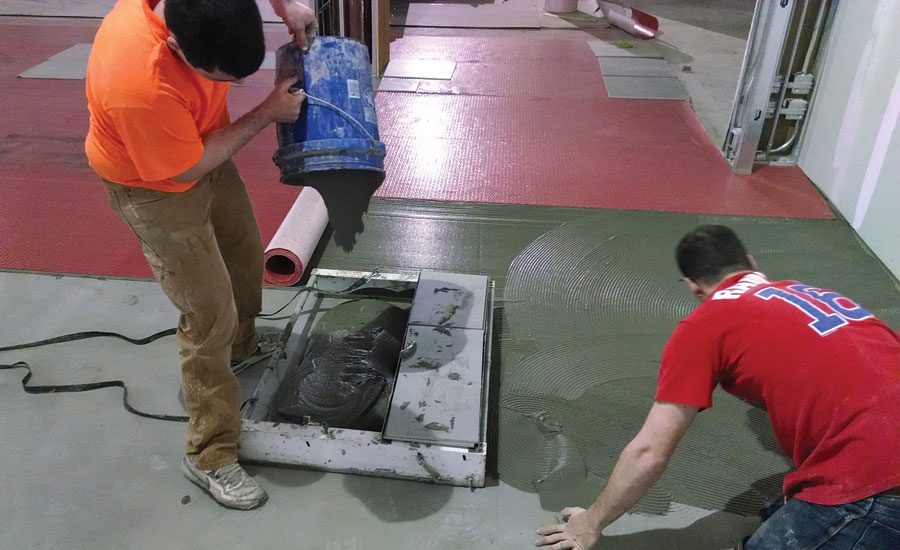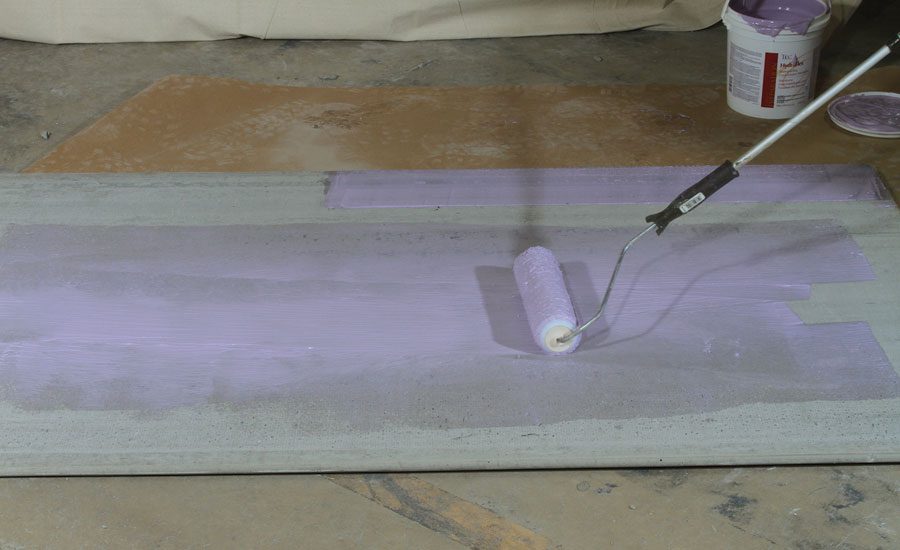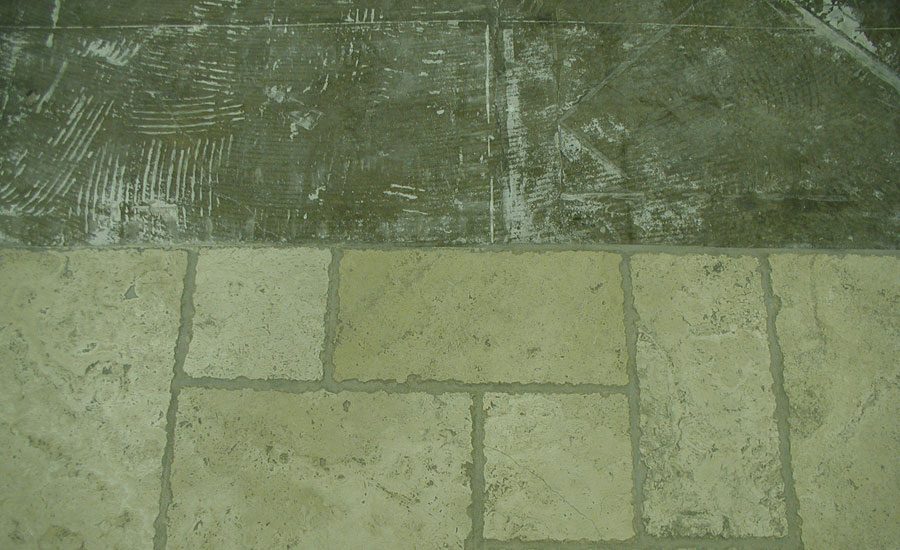Crack Isolation, Anti-Fracture and Uncoupling Membranes

Installing Loxcreen’s ProVa Flex uncoupling membrane.

An application of Custom Building Products’ RedGard Waterproofing and Crack Prevention Membrane.

Rolling on Tec’s HydraFlex waterproofing crack isolation membrane.

Installing a membrane improperly—or neglecting to install one at all—can lead to cracks telegraphing into the tile from the substrate. Photo courtesy of Alan Kin.




Most installation professionals understand what crack isolation, anti-fracture and uncoupling membranes are for, but confusion still reigns on what the differences are among the products. Do crack isolation and anti-fracture mean the same thing? Are uncoupling membranes standardized? When should partial coverage be chosen over a full installation? We asked a panel of industry manufacturers to weigh in.
Article Index:
Defining the terms
According to Eric Edelmayer, MAPEI’s business development manager for sheet membranes, the terms crack isolation and anti-fracture membranes are often used interchangeably, while uncoupling membranes are a different category altogether.
“With crack isolation or anti-fracture, the ANSI standard would be 118.12, with a defined amount of movement required to pass the test. At the present time, there is no measurement for uncoupling membranes other than the minimum 50 psi shear strength in seven days, as defined by the Tile Council of North America (TCNA) Handbook. However, the Material and Methods Standards Association has formed a committee to establish an ANSI standard for uncoupling membranes.”
Jay Conrod, Laticrete product manager, said the preferred industry term is crack isolation. He also noted some subtle differences in meaning between the terms. “Crack isolation is when you’re trying to isolate existing cracks from telegraphing from the substrate into the tile. Anti-fracture would be about preventing existing and future cracks. Uncoupling is when you’re trying to isolate stresses in the substrate via a membrane that moves independently of the floor surface.”
Custom Building Products’ Steve Taylor, director of technical and architectural marketing, explained the different terms as well. “Anti-fracture is sometimes considered an older term that was used to indicate the membrane would protect the tile from cracking if there was movement in the substrate. Unfortunately, many incorrectly believe these membranes should provide protection from all actions—above as well as below the tile.”
He added, “Many crack isolation membranes have multiple functions. Not only do they isolate the tile from cracks below, they also waterproof the floor and reduce sound transmission from impact noises. Uncoupling is a separate class of membrane. It does not have an ANSI standard and is only defined by TCNA as a geometric formed plastic membrane to provide an air space below the tile and allow independent movement between the tile assembly and the substrate.”
According to Michael Venturelli, QEP divisional vice president, crack isolation and anti-fracture are virtually synonymous. “They both perform by adhering to the slab; then the tile is set onto the crack isolation or anti-fracture membrane. The crack energy is absorbed by the product and spread over a large area, preventing telegraphing through the tile. In some cases, the crack may transfer to the grout joint. That is easily repairable.”
Regarding uncoupling membranes, Venturelli noted, “Uncoupling, also called a cleavage membrane, is a system that is centuries old. This is where the floor is completely isolated from the substrate. Hence, any force or movement on the subfloor is completely isolated from the finished floor.”
Loxcreen’s Duane Farley, national sales manager—Canada, and Wade Verble, ceramic industry specialist—U.S., said the term anti-fracture is usually associated with older technology such as peel-and-stick asphalt underlayments for use on concrete. Some products are also hybrids. “ProVa Flex is both an anti-fracture and an uncoupling membrane, and we like to define it as a ‘lightweight’ tile underlayment. It will not break apart and will handle deflection within industry standards. ProVa Mat is a waterproof anti-fracture membrane that can be used for crack isolation to deal with a small number of cracks in a large area.”
They added, crack isolation is ideal “for large jobs which have some cracks but not many, with the hope cracks don’t occur anywhere else. It’s for dealing with existing cracks.”
Going into greater detail about uncoupling membranes, Alan Kin, Texrite sales and technical, stated, “The uncoupling method is a layered system that tangentially hinges or has a moveable bond, like a train-car connection.”
He noted that using a crack isolation, anti-fracture or uncoupling system does not in any way circumvent the need for movement joints or expansion joints. “Addressing minor crack movement with a membrane system will not also cover all building, construction and movement joints.”
Application methods
Edelmayer stated that choosing a sheet, liquid or trowelable membrane comes down to the contractor’s preference. “However, performance levels may differ from product to product and manufacturer to manufacturer, so it is important to always check the ANSI standard for the required performance level.”
Conrod said choosing between the methods comes down to several factors. “It really depends on the application, the substrate, the type of tile or stone to be used, and whether you also need waterproofing. Sheet membranes are preferred if you need a quicker turnaround, such as in a mall or retail setting where you want to get in and get out really quickly. With trowel-applied products you can see some labor savings because you’re often applying anti-fracture and a thin-set in one application.”
Taylor also said sheet membranes are typically the fastest application. “Generally one must wait for a liquid-applied membrane to dry and cure, whereas you can begin setting tile on a sheet membrane immediately. Sheet-applied products can have a pressure-sensitive adhesive backing or be installed with a separate adhesive or mortar. Liquid-applied products can be applied with a roller, sprayer or trowel.”
Patrick Giles, vice president of technical and research & development for Maxxon, said his company recommends applications including trowel-applied, sheet-applied and uncoupling on its underlayments. “The TCNA has published installation methods over gypsum concrete (Method F180-12) and other substrates (Method F185-12). Maxxon gypsum underlayments should be completely dry when using trowel-applied or peel-and-stick sheet anti-fracture/waterproof membranes. Uncoupling membranes such as Schluter Ditra mat can go over a slightly wet Maxxon underlayment.”
Venturelli believes the most secure method is peel-and-stick sheets. “Homelux’s CIM Pro and Primer allows up to 3/8” separation movement in the substrate and prevents the crack from telegraphing through to the tile.”
He added, since liquid membranes are “only waterproof—not vapor-proof—this eliminates liquid membranes for use in steam rooms. Liquid membranes also need several coats and drying time in-between. Liquid and trowel-applied products generally will not handle the same type of movement as a sheet membrane would, as it is difficult to predict in-plane movement.”
Farley and Verble said the installer should choose an application system based on comfort level and manufacturer recommendations. “The installer should make sure the crack is 1/8” maximum in plane, as to industry standards. ProVa Mat is a great choice for crack isolation and must be 1.5 times wider than the tile. For example, for a 24” tile the installer should cover the crack with a 36” wide roll, making sure the crack is centered in the roll.”
Tom Plaskota, Tec technical support manager, stated that trowel-applied products sometimes have the advantage of acting as the adhesive for the tile as well. “Other products are allowed to cure prior to the tile installation or are applied as sheet goods and then serve as the substrate for the tile.”
According to Mark Pennine, Ardex tile & stone installation systems technical manager, uncoupling membranes can also offer several additional features. “Some uncoupling membranes can be used as vapor management and top-down waterproofing when a seam tape is used.”
Kin said that, when working with large-format tiles, liquid- and trowel-applied products remain the best option. “Liquid-applied membranes have limitless path width when working with large-format tiles, with no concerns for overlap or abutted sheet membrane requirements. An installation contractor should be aware of the proper coverage amounts or width required for larger-format tile situations, and recognize that one size/width application does not fit all tile sizes.”
Partial vs. full coverage
Edelmayer noted that choosing partial membrane coverage versus a full-field approach depends on the substrate itself. “Chasing individual cracks is very common in older pours or renovation work, where the substrate has already cracked and additional cracking is less likely. In new construction where the concrete may not have cracked yet or radiant heat is involved, a full-field approach is definitely the way to go. Same for those crack isolation membranes that are used for waterproofing.”
Taylor believes full coverage is the best option, even in older slabs. “Full coverage will protect the tile and grout from any new cracks that may form in the substrate. Older slabs may be stable and only require a partial install, but this is not necessarily true and we suggest full coverage in nearly all cases.”
Venturelli suggests that, when the subfloor is new, using an uncoupling mat for a full install is ideal. “However, if money is an issue, I would suggest using an anti-fracture membrane.”
Plaskota said that, whenever possible, covering the full installation area is the best option as it not only isolates visible cracks but prevents future cracking and movement. “In addition, using the membrane over the entire installation area and combining it with compatible products from the same manufacturer may improve the installation’s overall strength. For example, Tec membranes are formulated specifically to receive Tec bonding mortars. When they are used with other Tec mortars and grouts, they are eligible for a comprehensive limited warranty.”
According to Pennine, when choosing a partial install to isolate a crack, “materials must be applied a minimum of three times the width of the tile or stone being installed over the crack.”
Kin thinks it’s best to go with a full installation whenever possible, partly to help protect the contractor against possible claims. “A homebuilder may submit a claim for in-plane fractured/cracked tile. From practical experience, upon investigation or removal of the tile and mortar typically no membrane or an insufficient width of membrane will be present underneath the tile.”
He added that the option of a full coverage membrane should always be discussed with the customer before installation. “With the cost of construction being scrutinized, building owners and homeowners often comment about why they were not given the choice of full coverage membranes after experiencing failures or repairs. It is key that the installation/bidding group have better contact with the customer and allow them the choice of full coverage.”
Looking for a reprint of this article?
From high-res PDFs to custom plaques, order your copy today!










